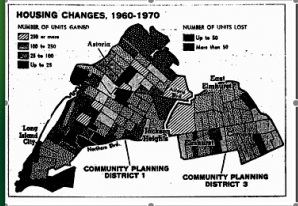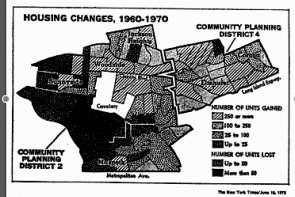Neighborhood downgradeFrom The Peopling of New York CityAfter World War II, the ethnic makeup of Jackson Heights changed dramatically. Jews began to move out of their old neighborhoods and into Jackson Heights in the 1950s, diversifying the white ethnic population that had been in the neighborhood since its founding. A major demographic shift occurred in the decades that followed. As with many other white ethnic working class New York City neighborhoods, the decentralization of the industrial economy and the development of the highway system combined to enable some long-time residents of Jackson Heights to move to suburban areas on Long Island. Importantly, however, the neighborhood did not suffer from the same mass drain of white residents as other neighborhoods, mainly because "any tendency toward panic selling was stemmed by the relative stability of co-op owners (or, perhaps, their inability to sell)" (Kasinitz, 168). The period between 1960-1970 was also one of rapid housing construction. Community District 3, of which Jackson Heights is a part, saw a net gain of 4,387 housing units (Burks). One scholar noted though that despite this increase in housing, the real estate market nonetheless lost value during this period (Miyares). However, the drop in housing costs opened the door for new immigrant families to take residence and open businesses in the neighborhood. Their presence in the city increased dramatically when the federal government lifted the restrictive, national-origin based immigration quotas in 1965. In the 1970s, New York City faced a major fiscal crisis. As in many other working class neighborhoods, the city dramatically cut services to Jackson Heights during this period, just as a major wave of new immigrants, many of whom were low-wage earners, were moving in. In 1971, even before the fiscal crisis hit, at a City Planning Commission hearing, Assemblyman Vincent Naro listed the following signs of the neighborhood's deterioration: "poor sanitation service, a lack of community centers for the community's army of young people, no offstreet parking and a nearly total absence of maintenance and protection in the scattered few parks and playgrounds available to the community" ("Neighborhood Report"). Many of the established residents of Jackson Heights blamed the newly-arrived Hispanic residents for the neighborhood's decline, and mainstream media accounts from this period noted growing tensions between established and new residents. For example, a 1976 New York Times article titled "Enterprising Hispanic Merchants Revive a Block in Jackson Heights," describes the ways that the neighborhood benefits economically from the activities of new immigrant residents. But it also notes that, "The new life on the block and all around the area has been injected by the flood of men, women and children from Latin America and the Caribbean that older residents of Jackson Heights predicted would destroy the neighborhood. Some still say so." Another article, two years later, draws an explicit connection between the neighborhood's new residents and neighborhood decline. It states: "The signs indicate the transition that has been taking place over the last decade in the pleasant, tree-lined, bedroom community - the moving out of older Irish, Italians and Jews and the influx of South Americans. For years, the transition went smoothly. The South Americans brought their own culture. Spanish-language newspapers began sharing the newsstands with the regular dailies. A Colombian grocery or bakery nestled easily next to a kosher butcher shop. Then came the murders that were linked to the cocaine trade, which, in turn, was tied to Colombians, the major concentration of South Americans in Jackson Heights." What is missing from this account, of course, is a discussion of the city's role in withdrawing resources and services, including police, from the neighborhood (Sanjek 2000). The 1978 article was one of many from the period that denounced the influence of Latinos in Jackson Heights. However, while some residents of Jackson Heights may have been at the center of a drug cartel, this criminal activity actually had little impact on the daily lives of most of the neighborhood's residents. This explains why many new immigrant groups -- groups who were not able to move into safer, more well-resourced neighborhoods because of racial discrimination -- settled in Jackson Heights (Kasinitz, 166).
(Source: Queens Community District 3 & NYC Department of City Planning) From 1980 to 1990, both the Hispanic and Asian population in Jackson Heights nearly doubled. The black population increased as well, but only slightly. During this period, the white population decreased by more than 28%. A similar trend followed from 1990 to 2000: the white population decreased by approximately 28.9 percent (9,373 residents), the Asian population almost doubled again with a 91.5% increase, the Hispanic population increased by 70.8%, and the black population increased by 10.4%. By 1990, whites were no longer a majority in the neighborhood. Rather, a new immigrant population comprised primarily of Asians and Hispanics became the majority. However, this "hyperdiversity" of Jackson Heights does not always result in a harmonious environment.
|

